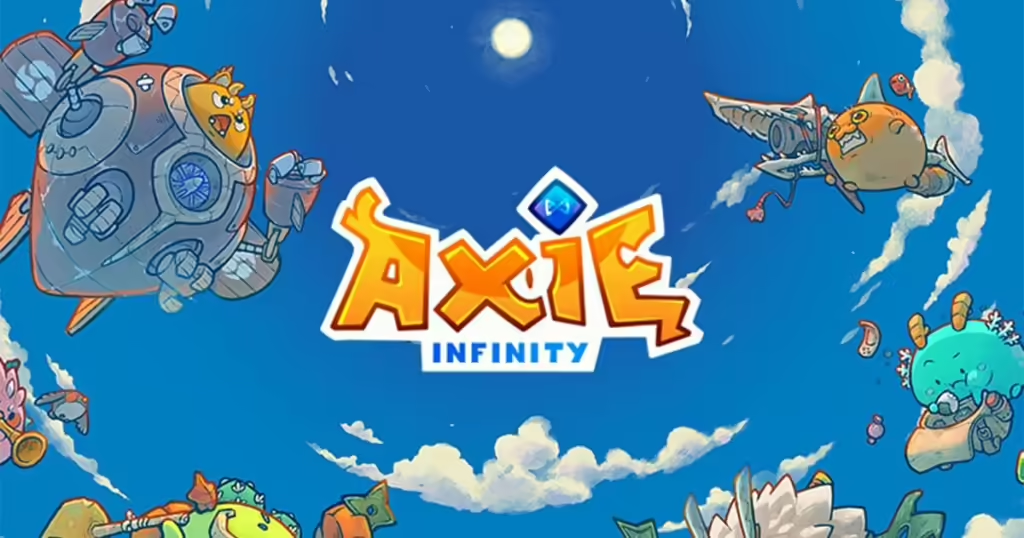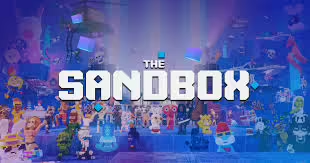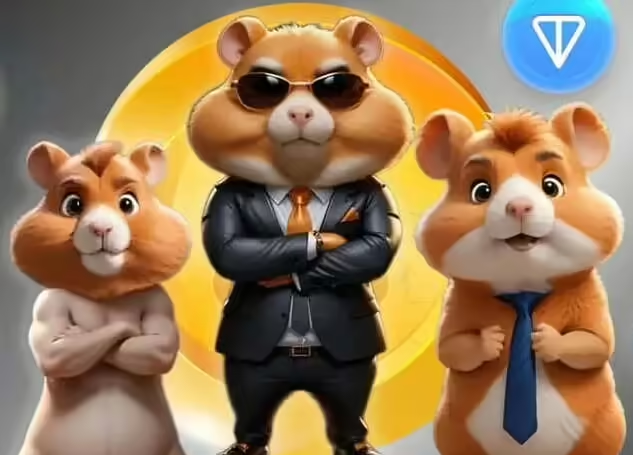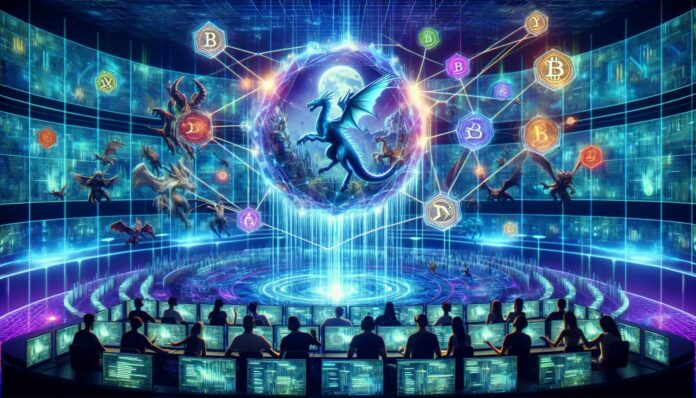Crypto gaming, which some also call Web3 or NFT gaming, is bringing a new age to the old-school gaming scene. Here, gamers get to be real-deal players in their game worlds. It’s all about using blockchain and NFTs, and this shakes up how game makers and players get along. These games stick tokens into the mix and flip the script on who owns stuff how stuff gets made, and how players get into the game in these online places.
The shift from Web2 to Web3 in the gaming world has sparked a bunch of big changes in how games get made, the cash flow, and how people in gaming communities interact. We’re gonna take a look at how using tokens in games can change how players get involved and the financial side of things. We’ll peek at some games that are killing it in the Web3 scene, like “Alien Worlds” and “Axie Infinity,” to see the kind of splash they’re making with gamers. Plus, we’re gonna chat about what all this means for the folks making games and what we might see happening with games that aren’t run by just one company in the days ahead.
Table of Contents
How Gaming’s Changed Big Time: From Old-School Web2 to the New Web3 Vibe
Back in the Day Gaming Setups
For a long time, the gaming industry had this top-down setup kind of throwing off the whole fair trade vibe between gamers and those who make the games. Folks playing the games poured time and cash into their fave games, but then they just had to ditch all that effort when the next big thing came out. It was a real bummer for player’s freedom and got in the way of creating these awesome worlds that stick around and all link up.
The Rise of Blockchain Technology
Then blockchain tech came along and turned things on their head regarding in-game money matters making sure players and game makers were aiming for the same goals. With blockchain games, your proof that you own cool digital stuff in games gets recorded onto this big ol’ communal record-keeping system. That twist means players get to prove they own their stuff letting them call the shots on selling, swapping, or using it.
Web3 Gaming Worlds
Web3 gaming worlds are causing a revolution in the gaming sector. They use blockchain tech to turn in-game stuff into NFTs or non-fungible tokens. This lets gamers own their in-game items and trade them across different platforms. This big change is shaking up how game makers build games and make cash. Firms like Sky Mavis and Animoca Brands are at the front of this gaming revolution with blockchain. They’re crafting new economic ways that change how games work. Thanks to these advances more folks are learning about games that get better with blockchain, and they want to get in on the action – playing web3 games and making some dough.
Tokenizing Stuff: Making Players Big-time Players
Players are getting more power as they become stakeholders, thanks to the process of tokenizing things in games.
In Web3 gaming, tokenization makes players a vital part of the game world by giving them significant stakes in the digital realms they play in. It uses different sorts of tokens to craft a game that’s both more fun and gives more back to the player.
Web3 games use two kinds of tokens: ones for governance and ones for utility. Tokens like “$ILV” in Illuvium let the people who own them have a say in big choices about where the game’s headed and how it grows. Utility tokens are different; they’re like money in the game and can stand for lots of stuff in the game world.
In Web3 gaming, the way folks help steer the game is by using these governance tokens. They get to put in their two cents on what happens next.
Players get the power to shape how Web3 gaming worlds work, thanks to governance tokens. They cast their votes using these tokens to tweak game rules how the economy works, and what comes next for the game. Making sure the game grows in ways that work out best for the people playing it keeps everyone in the loop and makes sure player interests are top priority.
Gaming By The People
Web3 gaming is all about letting players pitch in on building and shaping gaming universes. This team-up has sparked some pretty cool ideas and added stuff that usual game-making crews might not have thought up. Players having their say in how things get made in Web3 gaming means they’re more than just players – they care about what they’re helping to create.
Studies of Web3 Gaming Hit Projects
Alien Worlds

Alien Worlds made a name for itself as a top dog in the Web3 gaming space proving just how cool blockchain tech can be when you mix it with virtual worlds. This game got big super quick turning into the hottest NFT game around and letting its players pocket some crypto while they’re having fun. With a whopping 3.3 million peeps signed up, Alien Worlds shows that folks dig the whole play-to-earn scene in these online decentralized playgrounds.
In the game, players jump into the boots of future explorers—year 2055 style—and they’re all about digging up this stuff called Trilium (TLM) on seven different planets. Each of these worlds runs as its own decentralized autonomous organization (DAO), which means they’ve each got their own special way to play and their own set of NFT goodies. It’s this sweet twist on making game tokens and getting players to stick around that’s helped push Alien Worlds up the popularity charts.
Axie Infinity

Players in Axie Infinity get to mix gaming, collecting, and decentralized finance like a pro. They breed, fight, and trade Axies—these unique tokens you can’t swap one for another all on the Ethereum blockchain. Man, everyone’s talking about its earn-while-you-play style in Southeast Asia. Folks there can make their bread by just playing!
And get this, the game’s own digital money AXS, has blasted off to the moon—people who got in made out like bandits. Axie Infinity’s big splash has everyone buzzing about how this blockchain game scene could flip traditional gaming on its head.
The Sandbox

The Sandbox has secured its spot at the forefront of metaverse ventures creating a play-to-earn digital realm. Here, gamers have the power to possess, fashion, and cash in on virtual items. Big names like Snoop Dogg, Atari, and Deadmau5 are among the wave of partners this project has snagged.
At the core of The Sandbox’s digital ecosystem, you’ll find three key parts: the Marketplace, VoxEdit, and Game Maker. These components hand users the tools to whip up and wheel and deal digital goodies kinda lighting a fire under a booming economy that’s run by the community. SAND is The Sandbox’s homegrown token and it’s a big deal for buying stuff and having a say in the metaverse.
Catizen

Launched by Pluto Studio in 2024, Catizen, a play-to-earn (P2E) game, transformed players into stakeholders using new ways to tokenize. It’s part of Telegram’s mini-app ecosystem and lets players run online cat cafes to earn something called vKitty.
Here’s why the game’s way of getting the community involved with tokens is different:
- Token Holder Conversion: Catizen nailed a solid 6-8% rate of turning players into token holders.
- Savvy Airdrops: The platform gave out airdrops offering rewards to dedicated players for their game achievements.
- Launch of CATI Tokens: Giving players CATI tokens meant they got shares in how the game world runs.
- Perks for Players: Those owning tokens get to trade cheaper, help make game rules, and peek at new updates first.
- Smooth Token Switch: Catizen slipped into tokenization by swapping its current game money for blockchain tokens.
These tokenization moves come with a bunch of pluses:
- Players Get Into It: When players become part-owners, they care about how well the game does. This keeps them coming back more.
- Everyone Wins: This setup means both players and the folks who make the game get good stuff when the game does better.
- Making Some Cash: By trading or putting tokens into the game, players could make some money.
The way Catizen is rocking it shows that letting players own a piece of the game isn’t as tough as it looks if you’ve already got players who are loyal and a game that’s already got its own economy. This is all part of a big change going on in games, with blockchain stuff making it possible for players to own parts of the game and have a say in stuff.
The gaming world keeps changing, and Catizen’s way of doing things is a great example for other platforms wanting to turn their players into involved stakeholders. This could change how games and their fans interact.
Related Read: Catizen’s $CATI token price skyrocketed by 4700% as it goes live on Exchanges
Hamster Kombat

Everybody’s talking about Hamster Kombat, that game on Telegram where you just tap to get stuff. They’ve got this cool new plan to make their tons of players actual stakeholders with their own tokens. They’re rolling out this HMSTR token on September 26, 2024. There’s going to be a huge handout of 60 billion tokens to players who can get them, and people can’t wait.
Shaking up the game world big time, this move lets gamers own a piece of the game’s world. Hamster Kombat isn’t messing around – with a crazy 300 million players, 129 million are getting in on the airdrop. That’s huge and shows just how many folks can’t get enough of this game.
Now when it comes to spreading out the tokens, they’ve got this slick plan. You grab 88.75% of those tokens right off the bat, and the rest, the 11.25%, you gotta wait for July 2025 to get your hands on. They’re thinking smart – give players something now, but keep the game going strong for years.
Hamster Kombat isn’t just giving out rewards to its community; it’s turning them into real-deal stakeholders. This move is making the players more into it and hands-on. They’re using this thing called tokenization, and it might just kick off a whole new way of doing things in the gaming scene. Think fun meets money-making – a killer combo, right?
Related Read: Hamster Kombat Airdrop on 23rd Sept: Season 1 Rewards Cutoff Announced on 20th sept
Blockchain Technology and Smart Contracts
Web3 gaming leverages blockchain technology to transform the gaming landscape. This innovative approach uses smart contracts to bridge the gap between traditional gaming environments and web3 components. Smart contracts are self-executing programs that automate game mechanics, secure transactions, and manage ownership. They handle token distribution, NFT creation, and ensure transparency in the gaming ecosystem.
Non-Fungible Tokens (NFTs) in Gaming
NFTs have a significant impact on Web3 gaming, allowing players to truly own their in-game assets. These unique digital tokens represent various elements such as avatars, weapons, and virtual land. For instance, in games like Alien Worlds, players can own and trade NFT items in marketplaces, potentially accelerating their progress or acquiring rare assets that enhance their gaming experience. The scarcity and uniqueness of these NFTs are verifiable on the blockchain, adding value and fueling player interest.
Fungible Tokens and In-Game Currencies
Fungible tokens play a crucial role in Web3 gaming economies. These tokens often serve as in-game currencies, facilitating seamless trading of NFT items and rare assets. For example, the GameFi project Aavegotchi has rewarded players with over 1.5 million $GHST tokens to date. These fungible tokens provide a smooth trading mechanism, replacing cumbersome barter systems with a more fluid economy. As games gain popularity, sought-after assets can accrue substantial real-world worth, creating new opportunities for players in the play-to-earn model.
The Impact of Tokenization on Game Development
New Revenue Models for Developers
Tokenization in Web3 gaming has opened up innovative revenue streams for developers. By integrating blockchain technology, game studios can now benefit from ongoing economic activity within their virtual worlds. For instance, developers can earn from transaction fees, marketplace listings, and secondary market sales of NFT-backed in-game assets. This shift allows for a more sustainable income model compared to traditional one-time purchases.
Decentralized Game Design
Web3 gaming encourages a decentralized approach to game design. Developers can create immersive, dynamic worlds where every item, character, and piece of virtual real estate has real-world value and ownership. This approach fosters community-driven development, allowing players to participate in decision-making processes through governance tokens. Games like Illuvium and Outer Ring MMO exemplify this trend, enabling players to vote on significant developments and shape the game’s future.
Community Feedback and Iteration
Tokenization has enhanced the feedback loop between developers and players. Web3 games often establish dedicated channels for player feedback, creating a more collaborative development process [10]. This continuous engagement allows developers to iterate based on community input, leading to more player-centric game designs. Regular updates and transparent communication have become crucial in maintaining player trust and engagement in tokenized gaming ecosystems.
Challenges and Opportunities in Web3 Gaming
Scalability and Interoperability
As Web3 gaming gains traction, scalability and interoperability become critical factors for success. Blockchain networks must be able to handle high transaction volumes and support seamless cross-platform play. Ethereum, the most widely used blockchain for Web3 games, has faced scalability challenges in the past. However, solutions like layer-2 scaling and alternative blockchain platforms are emerging to address these issues and enable more efficient and cost-effective gaming experiences.
User Adoption and Onboarding
User adoption remains a significant challenge for Web3 gaming. Many players are unfamiliar with blockchain technology and may find the process of setting up cryptocurrency wallets and interacting with smart contracts daunting. To overcome this barrier, Web3 games must prioritize user-friendly onboarding processes and educational resources. Simplifying the user experience and providing intuitive interfaces will be crucial in attracting a broader audience to Web3 gaming.
Regulatory Challenges
As Web3 gaming involves tokenized assets and cryptocurrencies, it faces regulatory challenges in various jurisdictions. Governments and regulatory bodies are still grappling with the implications of blockchain technology and its use in gaming. Compliance with securities laws, anti-money laundering (AML) regulations, and consumer protection measures will be essential for the long-term sustainability of Web3 gaming. Developers and platforms must navigate these regulatory landscapes carefully to ensure the growth and legitimacy of the industry.
The Future of Web3 Gaming
Mainstream Adoption and AAA Web3 Games
As Web3 gaming continues to evolve, the industry is poised for mainstream adoption. The success of projects like Alien Worlds, Axie Infinity, and The Sandbox has demonstrated the potential for Web3 games to attract a wide audience. As more players discover the benefits of true ownership and decentralized economies, the demand for high-quality Web3 gaming experiences will grow. The development of AAA Web3 games, with advanced graphics, immersive gameplay, and robust tokenized economies, will further drive mainstream adoption.
Interoperability and Metaverse Ecosystems
Interoperability will play a crucial role in the future of Web3 gaming. As more games embrace tokenization and decentralized ecosystems, the ability for players to seamlessly transfer their assets and progress across different virtual worlds will become increasingly important. The development of interoperable standards and protocols will enable the creation of interconnected metaverse ecosystems, where players can explore, trade, and engage with a wide range of Web3 games and experiences.
Player-Driven Gaming and Decentralized Economies
Web3 gaming empowers players to become active participants in shaping the future of virtual worlds. Through governance tokens and decentralized decision-making processes, players will have a greater say in the direction and evolution of their favorite games. This player-driven approach will foster the creation of vibrant, self-sustaining decentralized economies within gaming ecosystems. As players become more invested in the success and growth of these virtual worlds, the potential for innovation and value creation will expand exponentially.
Conclusion: Embracing the Tokenized Gaming Revolution
Web3 gaming is causing a revolution in the industry, transforming players into active stakeholders through tokenization. This shift has a significant impact on game development, economics, and community dynamics, creating new opportunities for players to have a real stake in virtual worlds. The integration of blockchain technology and NFTs has led to the creation of decentralized gaming ecosystems, where players have true ownership of their digital assets and a voice in the game’s future.
As Web3 gaming continues to evolve, it’s likely to shape the future of the gaming industry. Projects like Alien Worlds, Axie Infinity, and The Sandbox are paving the way, showing how tokenization can create more engaging and rewarding gaming experiences. While challenges remain, the potential for Web3 gaming to create more equitable and immersive virtual worlds is clear. As more players and developers embrace this new paradigm, we can expect to see even more groundbreaking developments in the world of gaming.
FAQ on Web3 Gaming
What is Web3 gaming and how does it impact the traditional gaming industry?
Web3 gaming leverages blockchain technology and NFTs to create decentralized gaming ecosystems, transforming the relationship between developers and gamers. It allows players to become active stakeholders in virtual worlds, redefining ownership, value creation, and player engagement.
How does tokenization empower players in Web3 gaming?
Tokenization in Web3 gaming transforms players into active stakeholders by utilizing governance tokens and utility tokens. Governance tokens grant holders voting rights on crucial decisions about the game’s development, while utility tokens serve as in-game currency and can represent various assets within the game world.
Can you provide examples of successful Web3 gaming projects?
Some successful Web3 gaming projects include “Alien Worlds,” where players mine a resource called Trilium (TLM) across seven planets, “Axie Infinity,” which allows players to breed, battle, and trade Axies, and “The Sandbox,” a metaverse project offering a play-to-earn virtual world. These projects showcase the potential of blockchain technology in virtual worlds and play-to-earn mechanics.
What are the challenges and opportunities in Web3 gaming?
Challenges in Web3 gaming include scalability, user adoption, and regulatory issues, while opportunities include new revenue models for developers, decentralized game design, and the potential for mainstream adoption and AAA Web3 games.
Disclaimer: The information provided in this article is for informational purposes only and does not constitute financial advice. Investing in cryptocurrencies involves risks, and readers should conduct their own research and consult with financial advisors before making investment decisions. Hash Herald is not responsible for any profits or losses in the process.










![Top 5 Must-See TON Chain Airdrops in 2024 [Updated] Top 5 Must-See TON Chain Airdrops in 2024 [Updated]](https://hashherald.com/wp-content/uploads/2024/09/Ton-218x150.jpg)


